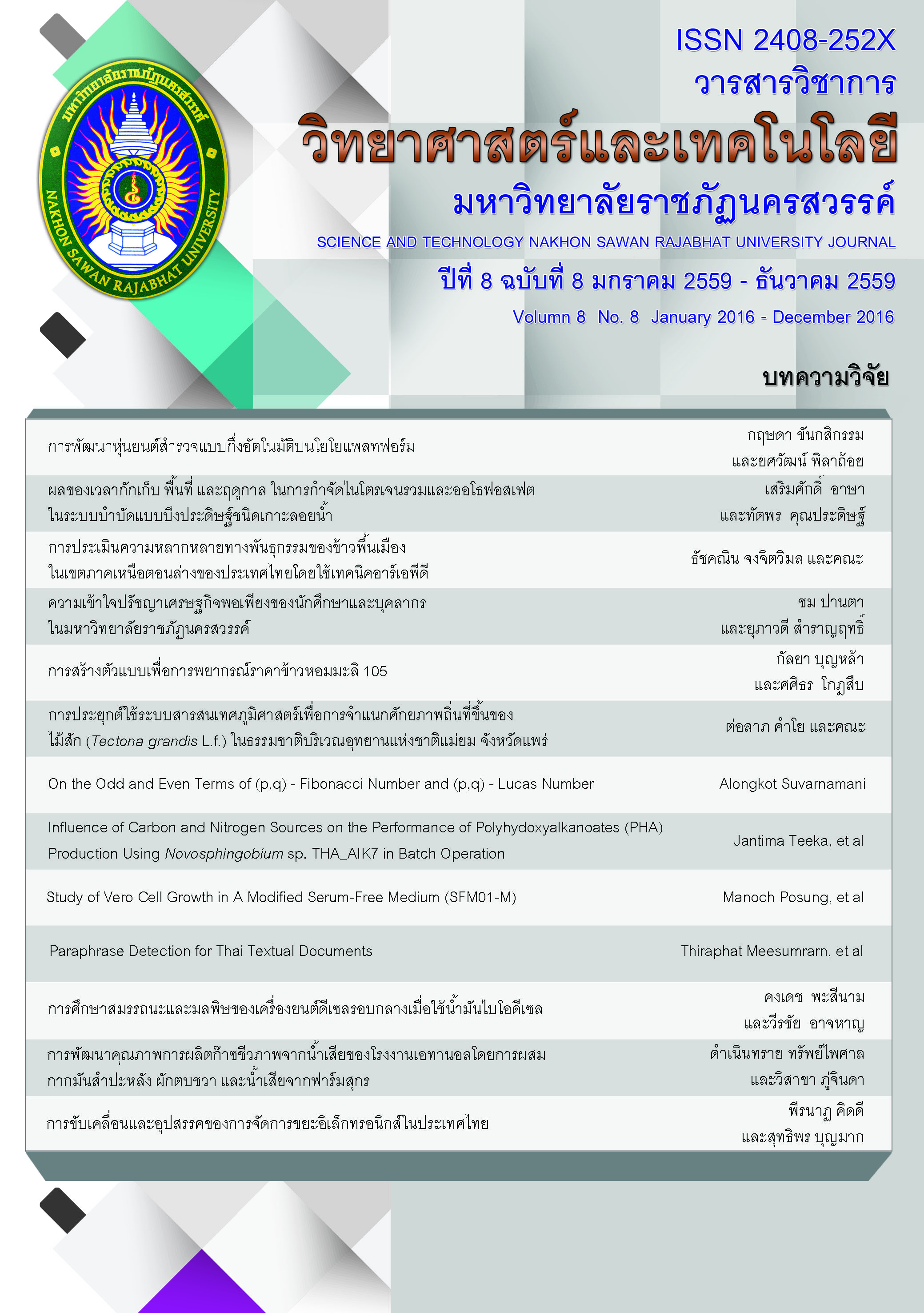Influence of carbon and nitrogen sources on the performance of Polyhydoxyalkanoates (PHA) production using Novosphingobium sp. THA_AIK7 in batch operation
Main Article Content
Abstract
Article Details
References
(1) Abid S, Raza. ZA and Hussain T. Production kinetics of polyhydroxyalkanoates by using
Pseudomonas aeruginosa gamma ray mutant strain EBN-8 cultured on soybean oil. Biotech. 2016; 6:142.
(2) Alias Z and Tan I. Isolation of palm oil utilizing, polyhydroxyalkanoates (PHA)-bacteria by an
enrichment technique. Bioresource Technology. 2005; 96:2729-2734.
(3) Anderson AJ and Dawes EA . Occurrence, metabolism, metabolic role and industrial uses of bacterial PHA. Microbiol Molecular Biol Rev. 1990;54:450-72.
(4) Bondioli P. and Della Bella L. An alternative spectrophotometric method for the
determination of free glycerol in biodiesel. Eur J Lipid Sci Technol. 2005;107:153–157.
(5) de Castro JS, Nguyen LD and Seppala J. Bioconversion of Commercial and Waste Glycerol
into Value-Added Polyhydroxyalkanoates by Bacterial Strains. J Microb Biochem
Technol. 2014;6: 337-345.
(6) Chanprateep S. Current trends in biodegradable polyhydroxyalkanoates. J Biosci Bioeng.
;110: 621–632.
(7) Dubois M, Gilles KA, Hamilton JK, Rebers PA, Smith F. Colorimetric method for
determination of sugars and related substances. Anal Chem. 1956;28(3): 350–356.
(8) Gouda MK, Swellam AE and Omar SH. Production of PHB by a Bacillus megaterium strain
using sugarcane molasses and corn steep liquor as sole carbon and nitrogen sources. Microbiol. Res. 2001;156:201–207.
(9) Kaewkannetra P, Tanonkeo P, Tanamool V. and Imai T. Biorefinery of squeeze sweet
sorghum juice into value added product of biopolymer, Journal of Biotechnology. 2008;136:S412.
(10) Muangwong A, Boontip T, Pachimsawat J and Napathorn SC. Medium chain length
polyhydroxyalkanoates consisting primarily of unsaturated 3‑hydroxy‑5‑cis‑dodecanoate synthesized by newly isolated bacteria using crude glycerol. Microb Cell Fact. 2016;15:55.
(11) Ramsay BA, Lomaliza K, Chavarie C, Dube B, Batalille P and Ramsay JA. Production of Poly-(β-hydroxybu¬tyric-co-β-hydroxyvaleric) Acids. Appl Environ Microbiol. 1990;56:2093-98.
(12) Shi H, Shiraishi M. and Shimazu K. Metabolic flux analysis for biosynthesis of
Poly(β-hydroxybutyric acid) in Alcaligenes eutropha from various carbon source. J Ferment Bioeng. 1997;84(6):579-587.
(13) Steinbüchel A. Perspectives for biotechnological production and utilization of biopolymers: metabolic engineering of polyhydroxyalkanoate biosynthesis pathways as a successful example. Macromol Biosci. 2001;1:1-24.
(14) Steinbüchel A and Valentin HE. Diversity of bacterial polyhydroxyalkanoic acids. FEMS Microbiol Lett. 1995;128:219-28.
(15) Suwannasing W, Moonamart S and Kaewkannetra P. Yields of Polyhydroxyalkanoates
(PHAs) during Batch Fermentation of Sugar Cane Juice by Alcaligenes latus and Alcaligenes eutrophus. Journal of Life Sciences. 2011; 5:960-966.
(16) Teeka J, Imai T, Reungsang A, Cheng X, Yuliani E, Yamaguchi J, Poomipuk N, Tiantanunkul J, Jeenanong A, Higuchi T, Yamamoto K. and Sekine M. Characterization of Polyhydroxyalkanoates (PHA) biosynthesis by isolated Novosphingobium sp. THA_AIK7 using crude glycerol. J Ind Microbiol Biot. 2012;39:749-58.
(17) Varsha YM and Savitha R. Overview on Polyhydroxyalkanoates: A Promising Biopol. J
Microbial Biochem Technol. 2011;3:099-105.
(18) Verlinden RAJ, Hill DJ, Kenward MA, Williams CD, Piotrowska-Seget Z, and Radecka IK. Production of polyhydroxyalkanoates from waste frying oil by Cupriavidus necator. AMB Express. 2011; 1:11: 1-8.


